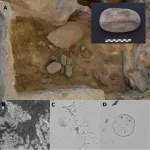(Press-News.org) A study conducted by researchers from the UPF Culture and Socio-Ecological Dynamics research group (CaSEs) and the University of Leicester (UK) has provided a highly dynamic image surrounding the use and importance of hitherto unknown wild plant resources at the Neolithic site of Çatalhöyük (Anatolia, Turkey). The researchers carried out their work combining the analysis of microbotanical remains and use-wear traces in various stone implements recovered from the site, which in the past hosted one of mankind's first agricultural societies.
The researchers carried out their work combining the analysis of microbotanical remains and use-wear traces in various stone implements recovered from the site
Çatalhöyük is a world heritage archaeological site located in Anatolia (Turkey), which was inhabited during the Neolithic, between 7,100 and 6,000 BC. This site has received worldwide attention due to its size and because it is one of the first urban centres with a high density of agglomerated dwellings, to which entry was gained through the roof and which contained elaborate wall paintings inside. The settlement was studied continuously for nearly three decades and provided a wealth of archaeobotanical remains (charred remains of plants) and a wide range of stone artefacts and tools used to process plant resources.
An innovative approach that analyses residue trapped on the surface of grinding implements
Despite the extensive research conducted in the area, much of what is known about agricultural practices and the use of plant resources, both at Çatalhöyük and in many other archaeological settlements, is based on the study of charred remains. However, these remains occur causally, either when cooking food or due to accidental fire, which gives a limited image of the use of plant resources in the past.
"We recovered residues trapped in the pits and crevices of these stone artefacts that date back to the time of being used, and then carried out studies of microbotanical remains and thus reveal what types of plants had been processed with these artefacts in the past"
The study, led by Carlos G. Santiago-Marrero, a predoctoral researcher with the Culture and Socio-Ecological Dynamics (CaSEs) research group of the UPF Department of Humanities, together with Carla Lancelotti and Marco Madella, ICREA-UPF research professors and members of CaSEs, and Christina Tsoraki, of the School of Archaeology and Ancient History at the University of Leicester (UK), used an innovative approach based on the analysis of microscopic remains taken from grinding implements from three domestic contexts, attributed to the Middle (6,700-6,500 BC) and Late (6,500 -6,300 BC) periods of occupation.
"We recovered residues trapped in the pits and crevices of these stone artefacts that date back to the time of being used, and then carried out studies of microbotanical remains and thus reveal what types of plants had been processed with these artefacts in the past", the researchers explain.
Among the microscopic remains studied by the researchers are phytoliths, from the deposition of opal silica in plant cells and cell walls, that provide clues about the presence of anatomical parts, such as the stems and husks of plants, including wheat and barley. Another residue studied are starches, glucose compounds, created by plants to store energy, which are found in large quantities in many edible parts of plants, such as seeds and tubers.
Thanks to combining these two lines, the researchers have shown that although the community of Çatalhöyük was based on an agricultural economy by definition, growing cereals and vegetables (wheat, oats, peas), there continued to be much exploitation of wild resources outside the spectrum of domestic resources, which had not yet been found at this site.
Use of wild plant resources to diversify the diet, through complex processing
"Microbotanical evidence has contributed to our knowledge about the plants used in the past and helped identify the presence of wild plants and various aspects related to possible strategies to exploit these resources, both to diversify the diet and to replace any calorie deficit that may have arisen in times of scarcity", the researchers assert. These wild plant resources were as important as domestic ones, and were most likely used regularly to supplement the core diet.
These wild plant resources were as important as domestic ones, and were most likely used regularly to supplement the core diet.
"Among our findings we have shown that the community used a wide range of tuberous plants, many of them belonging to potentially toxic taxonomic families, which require complex processing or use. This shows the great phytocultural knowledge possessed by this community", the authors underscore. And they add: "Many of these tuberous plants had highly restrictive seasonal life cycles, which has helped us to infer the possible means of organizing and exploiting the plant environment at different times of the year".
Moreover, another important aspect revealed by the study is the processing of wild millet seeds, which had never been found among the charred remains of plants on the site.
Use-wear traces on the surfaces of processing implements denoting various uses
The analysis of use-wear traces on the surfaces of plant processing implements, produced by use in various activities, has allowed the researchers to infer different tasks for which the tools were used.
Thanks to these analyses, they have discovered very diverse life histories of these implements and the close relationship with various aspects related to the processing of plant resources and other domestic activities. "By combining microbotanical evidence with use traces, we have discovered processes such as grain husking, the milling of legumes, tubers and cereals, and even the use of these implements in other activities not related to plant processing".
INFORMATION:
Reference article: Santiago-Marrero, C., Tsoraki, C., Lancelotti, C., and Madella, M. (June 2021). "A microbotanical and microwear perspective to plant processing activities and foodways at Neolithic Çatalhöyük". PLOS ONE
https://doi.org/10.1371/journal.pone.0252312
Topological semimetals are one of the major discoveries in condensed-matter physics in recent years. The magnetic Weyl semimetal, in which the Weyl nodes can be generated and modulated by magnetization, provides an ideal platform for the investigation of the magnetic field-tunable link between Weyl physics and magnetism.
But due to the lack of appropriate or high quality specimens, most of the theoretically expected magnetic topological semimetals have not been experimentally confirmed. Therefore, exploration of new magnetic topological semimetals is of great importance.
Recently, ...
The absorption of energy from laser light by free electrons in a liquid has been demonstrated for the first time. Until now, this process was observed only in the gas phase. The findings, led by Graz University of Technology, open new doors for ultra-fast electron microscopy.
The investigation and development of materials crucially depends on the ability to observe smallest objects at fastest time scales. The necessary spatial resolution for investigations in the (sub-)atomic range can be achieved with electron microscopy. For the most rapid processes, ...
Artificial microswimmers have received much attention in recent years. By mimicking microbes which convert their surrounding energy into swimming motions, these particles could soon be exploited for many important applications. Yet before this can happen, researchers must develop methods to better control the trajectories of individual microswimmers in complex environments. In a new study published inEPJ E, Shubhadeep Mandal at the Indian Institute of Technology Guwahati (India), and Marco Mazza at the Max Planck Institute for Dynamics and Self-Organisation in Göttingen (Germany) and Loughborough University (UK), show how this control could be achieved using exotic materials named 'nematic liquid crystals' (LCs) - whose viscosity and elasticity can vary depending on the direction ...
A new model tracking the vertical movement of algae-covered microplastic particles offers hope in the fight against plastic waste in our oceans.
Research led by Newcastle University's Dr Hannah Kreczak is the first to identify the processes that underpin the trajectories of microplastics below the ocean surface. Publishing their findings in the journal Limnology and Oceanography the authors analysed how biofouling - the accumulation of algae on the surface of microplastics, impacts the vertical movement of buoyant particles.
The researchers found that particle properties ...
Informing people about how well the new COVID-19 vaccines work could boost uptake among doubters substantially, according to new research.
The study, led by the University of Bristol and published in the British Journal of Health Psychology, shows the importance of raising awareness of vaccine efficacy, especially if it compares very favourably to another well-established vaccine.
The research focused on adults who were unsure about being vaccinated against COVID-19. Those who were given information about the vaccine's efficacy scored 20 per cent higher on a measure ...
Scientists at Tokyo Institute of Technology have developed a computational method based on large-scale molecular dynamics simulations to predict the cell-membrane permeability of cyclic peptides using a supercomputer. Their protocol has exhibited promising accuracy and may become a useful tool for the design and discovery of cyclic peptide drugs, which could help us reach new therapeutic targets inside cells beyond the capabilities of conventional small-molecule drugs or antibody-based drugs.
Cyclic peptide drugs have attracted the attention of major pharmaceutical companies around the world as promising alternatives to ...
Rescuing a member of their own social group, but not a stranger, triggers motivational and social reward centres in rats' brains, suggests a report published today in eLife.
The study provides the first description of similar brain activity in both rats and humans underlying this socially biased behaviour. The findings add to our understanding of social biases and could help with developing ways to promote cooperation outside of an individual's social group.
"Humans, as well as many other creatures, are biased toward helping other members of their social groups ...
Crenarchaeol is a large, closed-loop lipid that is present in the membranes of ammonium-oxidizing archaea, a unicellular life form that exists ubiquitously in the oceans. In comparison to other archaeal membrane lipids, crenarchaeol is very complex and, so far, attempts to confirm its structure by synthesizing the entire molecule have been unsuccessful. Organic chemists from the University of Groningen have taken up this challenge and discovered that the proposed structure for the molecule was largely, but not entirely, correct.
Crenarchaeol contains 86 carbon atoms and is a 'macrocycle, a large closed loop. No fewer than 22 positions in the molecule are chiral. The molecule can be present in two forms that are each other's mirror image, like a left and a right hand. In the crenarchaeol ...
A new University of Iowa study suggests that metabolism of plant-based dietary substances by specific gut bacteria, which are lacking in patients with multiple sclerosis (MS), may provide protection against the disease.
The study led by Ashutosh Mangalam, PhD, UI associate professor of pathology, shows that a diet rich in isoflavone, a phytoestrogen or plant-based compound that resembles estrogen, protects against multiple sclerosis-like symptoms in a mouse model of the disease. Importantly, the isoflavone diet was only protective when the mice had gut microbes capable of breaking ...
MORGANTOWN, W.Va.--Just as helicopter traffic reporters use their "bird's eye view" to route drivers around roadblocks safely, radiation oncologists treating a variety of cancers can use new guidelines developed by a West Virginia University researcher to reduce mistakes in data transfer and more safely treat their patients.
Ramon Alfredo Siochi--the director of medical physics at WVU--led a task group to help ensure the accuracy of data that dictates a cancer patient's radiation therapy. The measures he and his colleagues recommended in their new report safeguard against medical errors in a treatment that more than half of all cancer patients receive.
"The most common mistake that happens in radiation oncology is the transfer of information from one system to another," Siochi, ...






